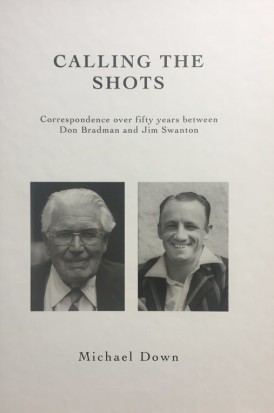Calling The Shots
Martin Chandler |Published: 2017
Pages: 57
Author: Down, Michael
Publisher: Boundary Books
Rating: 4 stars

Its author/publisher describes Calling The Shots as a ‘vanity project’, but don’t be fooled by that. The mere fact that much of its narrative content has appeared in the last couple of years, albeit in a slightly different form, in recent editions of the excellent Australian journal Between Wickets should not in any way detract from the importance of this: an expanded and fully illustrated account of the written dialogue that took place between Donald Bradman and EW ‘Jim’ Swanton over half a century.
If the game is still played in a thousand years’ time I cannot imagine that Bradman will need any more introduction than he does now. Swanton’s legacy on the other hand is not enshrined in the game’s records. He was a good enough cricketer to play First Class cricket, but only three times. His great contribution as a writer is something that future generations of cricket lovers will need to be reminded of.
For now, however, anyone who picks up a copy of Calling The Shots will know Swanton and his formidable reputation. His friendship with Bradman began when they first met whilst Swanton was covering the 1946/47 Ashes series and continued for the rest of their long lives. We might ask ourselves if the relationship a synergy for the good of the game, or merely a conduit that each man made use of to further his own agenda?
Bradman’s desire to see changes to the leg before wicket law to make bowlers’ lives easier is well known and it is a subject to which his letters return time and again. Of particular interest is the first letter, chronologically, that is considered at any length. For once it was not from Bradman to Swanton, but from Bradman to the MCC. Written at the height of the ‘Bodyline Crisis’ it is a thorough and, it has to be conceded, compelling treatise on why the law should change. Remarkably, the letter was never even acknowledged let alone responded to.
At various times the Don also looked for support for his campaign against illegal bowling and to advance his arguments against the front foot no ball law. As for more mundane matters, there is a running commentary on the health of himself and Lady Bradman, and occasionally some of his personal bêtes noires come to the surface. There is mention of his old teammates turned pressmen O’Reilly and Fingleton, with whom he seldom saw eye to eye. The old scars of the 1932/33 series re-open occasionally, especially when Swanton sends his friend a copy of his biography of Gubby Allen. The bitterness never dims – ‘The Don’ certainly knew how to bear a grudge.
As for Swanton he, unsurprisingly, uses Bradman’s ideas and agendas as a source of material for his writing, often but not always at the latter’s instigation, so the benefits of the correspondence certainly did not all flow in one direction. It is perhaps only natural that these two giant personalities were more often than not on the same wavelength, although the one area where they differed may be is perhaps unexpected. It was on the thorny question of South Africa. That Bradman, like many cricketers who could not see beyond the game itself, was supportive of continuing sporting relations with the country is no great shock. That the rather pompous and establishment-orientated Swanton was much more of the ‘no normal sport in an abnormal society’ school of thought is certainly interesting. Swanton was a man who could very easily have become little more than a caricature of himself, were it not for the fact that despite his many ‘old-fashioned’ traits and snobbish affectations he was always receptive to progress and change. As another example, unlike many of his generation, he was able to see the One Day game as being important to cricket’s future.
In the acknowledgments at the end of the book Mike Down tenders his apologies to his wife and teenage son for the many hours he spent at his computer honing the articles and then the complete work into shape. If they need any consolation (and I suspect they probably don’t), I can assure them they were hours well spent, and that the resulting insights provide a book that all cricket tragics will enjoy immensely. The only real problem is that in the best tradition of Boundary Books this is a limited edition, and there are only a hundred to go round. There are a significant number of people who are particularly fascinated by Bradman, or by Bodyline, and the prospect of new insights into both suggests that there may not be enough copies to satisfy demand. Early ordering in time for Christmas would seem to be the order of the day.
Calling The Shots is only available from Boundary Books (mike@boundarybooks.com), at a cost of £40 plus £3 postage and packing to UK addresses






Leave a comment